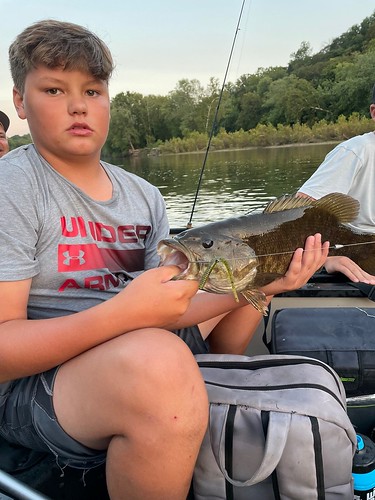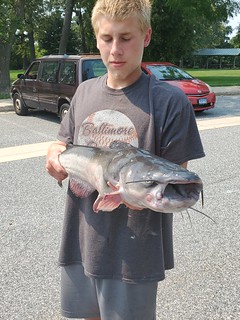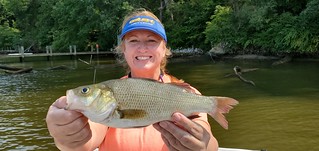
Ean Boyer got to go fishing on the upper Potomac River with his dad and caught this beautiful smallmouth bass. Photo by Cory Boyer
Summer is still holding sway over the Maryland landscape but cooler weather keeps slipping in with more frequency. All of this makes for the perfect opportunities to enjoy the outdoors with family and friends.
For anglers who want to learn or brush up on boating skills, the Maryland Department of Natural Resources and partners are sponsoring free “Welcome to Boating” clinics at Sandy Point State Park this weekend. The clinics — held on Friday September 17 from 11 a.m. to 7 p.m. and Saturday, September 18 from 10 a.m. to 4 p.m. — will provide instruction for new and experienced boaters on how to properly launch, load, retrieve, and dock a trailerable boat. More information is available on the DNR website.
Forecast Summary: September 15 – September 21:
Chesapeake Bay conditions will continue to stabilize this week after last week’s storm. Rain is possible late Thursday and Friday followed by sunny conditions the rest of the week. After a windy Thursday, expect low wind conditions the rest of the week. Bay surface water temperature has cooled and is holding in the upper 70s. In addition, cooler freshwater flows have resulted in decreasing surface water temperatures that will provide anglers opportunities to catch fish in shallower waters and during daylight hours.
Adequate oxygen levels are found at all depths from the Susquehanna Flats to Still Pond and at Swan Point. Due to low bottom oxygen levels, avoid fishing below the following depths in these locations: Bay Bridge to Bloody Point, 30 feet to 40 feet; Choptank River to Point No Point, 20 feet to the bottom. On the Potomac River from Colonial Beach to Piney Point, avoid fishing deeper than 15 feet to 30 feet. Conditions can vary daily so be sure to check the depth-to-oxygen level online prior to your next fishing trip to check your specific location.
Expect normal flows for most Maryland rivers and streams. There will be above average tidal currents Friday through the rest of the week as a result of a full moon on September 21.
Expect average clarity for many of the Maryland portions of the Bay and rivers, except the Middle Patuxent, Bush, and Back River. To see the latest water clarity conditions, check Eyes on the Bay Satellite Maps.
For more detailed and up-to-date fishing conditions in your area of the Bay, check the Maryland DNR website for Click Before You Cast. Get regular updates on Maryland’s waters sent to your inbox with our Eyes on the Bay newsletter. Sign up online.
Upper Chesapeake Bay

Richard Sharnas IV holds up a gnarly looking blue catfish for the camera. Photo by Richard Sharnas
Flows at the Conowingo Dam are now holding to a typical afternoon power generation schedule. The Susquehanna is still stained and in the area below the mouth of the river there is still quite a bit of floating debris from last week’s storm. Fishing for striped bass in the Susquehanna Flats has not been good for the past week but conditions are improving, and the mouths of the eastern tidal rivers have been an option where clearer water conditions prevail. Casting poppers with internal rattles or crankbaits with rattles can help fish locate your offerings in these stained water conditions.
Fishing for a mix of channel and blue catfish has not missed a beat. Anglers are catching them in the lower Susquehanna River and surrounding tidal rivers, and out in the upper Bay. Those chunking or chumming with menhaden are seeing quite a few catfish in their chum slicks, and any menhaden bait allowed to rest on the bottom will certainly attract the attention of catfish.
Fishing for striped bass in the upper Bay has improved this past week and those live lining spot should find fish holding at Swan and Love points, the mouth of the Patapsco River, the Sandy Point Light, and the Podickory Point channel edge. The eastern side of the upper bay tends to show clearer water conditions. There are still plenty of spot to be found in about 12 feet of water at the mouth of the Magothy River, the shallow ends of the Bay Bridge, and other shallow hard-bottom areas.
Jigging along channel edges is gaining more success as the striped bass begin ever so slowly to move into a fall pattern of feeding behavior. Baitfish in the form of juvenile menhaden are moving down from the upper reaches of the tidal rivers and will be exiting into the Bay the next couple of weeks. Water temperatures in most tidal rivers are now in the 70s. Trolling can be a good option also along channel edges with small spoons and umbrella rigs with bucktail or swimshad trailers.
The recent stained waters have not been helpful for upper Bay white perch fishing, but it is steadily improving with clearer water conditions. The middle sections of the region’s tidal rivers are good places to cast beetle spins and spinners in the morning and evening hours. Bottom rigs baited with pieces of bloodworm, peeler crab, or shrimp work well in deeper waters.
Middle Bay

Ian Bergendahl is all smiles with this nice 14-inch white perch he caught in the South River. Photo by Pam Bergendahl
Fishing for striped bass in the middle Bay is steadily improving as anglers enjoy light-tackle casting and jigging as well as live lining spot and trolling. The early morning and late evening shallow water striped bass fishery is offering a lot of fun fishing as water temperatures drop into the 70s. Casting topwater lures and paddletails are two of the most popular lures and ways to fish. Eastern Bay, the Poplar Island Rocks, Thomas Point and the shorelines at the mouth of the Choptank and Severn rivers are good places to fish. The Kent Narrows is a great place for land-based anglers to get in on the action.
As water temperatures cool, jigging along channel edges where fish can be found suspended is improving. The channel edges of the shipping channel, Bloody Point, Thomas Point, and the mouth of the Choptank are just a few of the better locations to investigate. These areas can also offer good success for those trolling umbrella rigs, tandem rigged bucktails and swimshads or small Drone spoons down deep. A fair percentage of the striped bass can be undersized so treat them with care when releasing — these are our legal fish for next year.
Live lining spot is still a very popular way to fish for striped bass as long as the supply of spot continues. The Bay Bridge piers, the outside edge of Hacketts Bar, the Gum Thickets, Bloody Point, Thomas Point, the Sharps Island Light, and the False Channel are a few of the more popular locations where striped bass are being found suspended. Spot are still being found in many hard bottom areas in 12 feet to 15 feet of water off Chesapeake Beach, Whitehall Bay, Eastern Bay, and inside the mouth of the Choptank near Black Walnut Point.
Spanish mackerel are still being found in the middle Bay chasing schools of bay anchovies on the surface and anglers are enjoying catching them. Casting small but heavy jigs and retrieving them at top speed is always an exciting way to hook up with Spanish mackerel. Trolling is a tried and true option. Pulling small gold or multicolored Drone spoons behind planers at 7 to 8 knots is the way to target the Spanish mackerel along channel edges and the outside edges of slicks or breaking fish.
Fishing for white perch is a viable option for anglers wishing to enjoy some light tackle action from shore or small boats. Casting beetle spins, small spinnerbaits, and spinners is always fun in the morning and evening hours along shoreline structure. Some of the largest white perch are caught this way. Fishing with grass shrimp or pieces of bloodworm on a simple bottom rig near dock and pier pilings is another excellent way to catch white perch. A good running tide is needed since slack tide often shuts down the perch and brings out the oyster toadfish.
Lower Bay

Karin Britt had a fun day fishing on the Patuxent River and catching some nice white perch. Photo courtesy of Karin Britt
Spanish mackerel continue to be a favored target for anglers in the lower Bay. These fish are chasing schools of bait along channel edges, and can be caught by casting small but heavy jigs into the breaking fish. Bluefish are part of the mix so speed-reeling one’s jig can usually thwart the bluefish that will try to attack. Slower speeds will help put bluefish in the boat, and perhaps the grill or smoker.
Trolling is a popular option and a great way to cover a lot of water. Small gold or those with colored stripes have been working best when pulled behind planers at 7 to 8 knots. The channel edges near the HI Buoy, north of the Target Ship, Buoy 72, the lower Potomac, and Tangier Sound are great places to find the Spanish mackerel. Some larger bluefish are also being reported in the Tangier Sound area.
Anglers casting a variety of soft plastic jigs and paddletails along the shores of the Bay and lower Potomac River for striped bass and speckled trout are being treated to slot-size red drum. The slot size is 18 inches to 27 inches with a creel limit of one per day. Tangier and Pocomoke sounds are also providing the same action.
September 15 is the last day of the 2021 cobia season in Maryland, so going forward any cobia caught as an incidental catch will need to be released. The catch and release of large red drum is still in full gear and those that are prepared for them with stout tackle are enjoying the action. It pays to have some heavy gear rigged with a large soft plastic jig, large spoon, or a soft crab bait ready to go when wandering the lower Bay. Those trolling for striped bass or bluefish are placing at least one large spoon in their trolling spread, while others specifically target the large red drum when one has a notion where they may be. The area north of the Target Ship, the channel edge from Buoy 72 to 72A, and the Middle Grounds are good places to look.
Fishing for a mix of spot, white perch and small croaker continues to be good in several areas of the lower Bay region. The mouth of the Patuxent River, the lower Potomac River from Cornfield Harbor up to Cobb Island, and the Tangier and Pocomoke sounds are all good places to get in on the action.
White perch can also be found in the region’s tidal rivers and creeks and can be caught by casting beetle spins, spinnerbaits, or spinners in the morning or evening hours along shorelines. Fishing with grass shrimp, small minnows, or pieces of bloodworm on a bottom rig also works well in deeper waters.
There are still blue crabs for recreational crabbers to catch in the middle sections of the tidal rivers down to the Bay. The best crabs are coming from waters in the 12-foot to 15-foot depths; smaller crabs tend to be in shallower waters. Trot lines and collapsible crab traps are both working well and the edges or transition edges from shallow to deep water tend to offer the best catches.
Freshwater Fishing
Anglers are beginning to see cooler nights and lower water temperatures ever so slightly from Western Maryland to the Eastern Shore. Most freshwater fish are still holding to a summer mode of behavior, but the morning’s best fishing hours are extending a little later and the evening bite starting a little earlier. Most have noticed sunrise is later each week and sunset a bit earlier — approaching the equinox we have about 12 hours of daylight. Soon aquatic grasses will begin to fade, much cooler water will occur, and we’ll be into a fall pattern of fish activity.

Five-year-old Sylvia Bialek caught her first fish while fishing with her dad and it was a sunfish. Photo by Anthony Bialek
The DNR trout hatchery program is gearing up for the fall trout stocking in early October. These stockings will offer some fun fishing for anglers in a wide range of locations across the state. The word is that the trout are in great shape due to good water flows at the hatcheries this summer. There will also be the bonus of trophy-sized trout being stocked at every location. The stockings will be posted on the DNR website soon after they take place. You can also be notified by our email subscription service.
The upper Potomac River is in good shape for fishing. Smallmouth bass can be found in deep current breaks, submerged ledges, and eddies behind large boulders. A variety of small crankbaits, craws, tubes and jigs will be good choices for baits. Biologists recently completed smallmouth bass juvenile surveys of the upper Potomac River. Seine samples were conducted at multiple stations from Seneca upstream to Oldtown. The average number of smallmouth bass young of the year collected per haul was 0.82 fish. This is just below the long-term median score of 0.95 fish per haul. Annual smallmouth bass boat electrofishing surveys will be conducted later this fall to monitor the adult population.
Fishing for largemouth bass continues to be good this week for those anglers fishing the morning hours in the shallower grassy areas with topwater lures. Buzzbaits and frogs tend to be a popular choice. When open spaces can be found between lily pads and grass, jerkbaits, paddletails, spinnerbaits, and lipless crankbaits work well. In the tidal areas, northern snakeheads will often be part of the catch. They are hungry and ready to attack most anything that moves.
As the morning hours stretch into midday, largemouth bass are still looking for cool shade under thick grass mats in slightly deeper waters, or retreating to deeper waters to find that cool shade near sunken wood. Overhanging brush, fallen treetops, and docks should not be overlooked. Flipping wacky rigged worms near the spots where largemouth bass are waiting out the day is the best tactic to target the largemouth bass.
Crappie are holding near deep structure and can be targeted with small minnows or marabou jigs under a slip bobber. Bluegill sunfish and other sunfish species are usually holding near deep grass and lily pads, and can be caught in a variety of ways. Perhaps one of the most fun ways to target them is with a lightweight fly rod, a floating line, and small rubber-legged poppers or floating flies such as beetles, ants, and grasshoppers. Fishing with small jigs and similar lures on a light spinning outfit is a lot of fun. The old standby of a worm or cricket under a bobber never fails and a great way for our younger anglers to get in on the action.
Atlantic Ocean and Coastal Bays

This lucky angler managed to catch a double on flounder recently. Photo by Monty Hawkins
Those fishing in the surf are enjoying some beautiful weather and a mix of small summer species. Fishing bottom rigs baited with pieces of bloodworm, Fishbites, and squid are providing some action with kingfish, spot, croakers, and flounder. Using cut spot is a good way to target small bluefish in the surf. Now and then a few pompano are being caught on sand fleas.
At the inlet and Route 50 Bridge area, bluefish are being caught on jigs and Got Cha lures or by drifting cut bait. Striped bass are being caught during the morning and evening hours by jigging with bucktails and soft plastic jigs. Although a fair percentage of the striped bass fail to meet the 28-inch minimum, they offer fun catch-and-release action.
Flounder fishing in the back bay channels remains good as long as waters remain clear. Most are fishing with squid and minnows and quite a few croakers are being caught on squid baits. Fishing with large Gulp baits on a jig head or live lining small mullet or spot is a good way to target the larger flounder.
Outside the inlet, those trolling near the shoal areas are catching Spanish mackerel on Drone and Clark spoons and false albacore at times. Farther offshore the boats fishing the wreck and reef sites are doing very well catching black sea bass, small dolphin. and large flounder.
A mix of white marlin, blue marlin, yellowfin tuna, and the occasional sailfish are being caught at the canyons by the boats trolling. Anglers that are deep-dropping are bringing blueline tilefish back to the docks.
“The sporting qualities of a fish are not dependent neither on its size nor its weight, but on the effort of concentration, the skill and mastery it demands from the fisherman.” — Charles Ritz
Maryland Fishing Report is written and compiled by Keith Lockwood, Maryland Department of Natural Resources fisheries biologist.
Click Before You Cast is written by Tidewater Ecosystem Assessment Director Tom Parham.
This report is now available on your Amazon Echo device — just ask Alexa to “open Maryland Fishing Report.”
